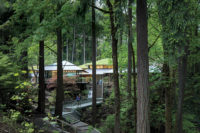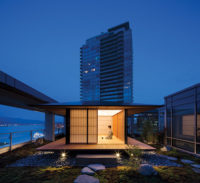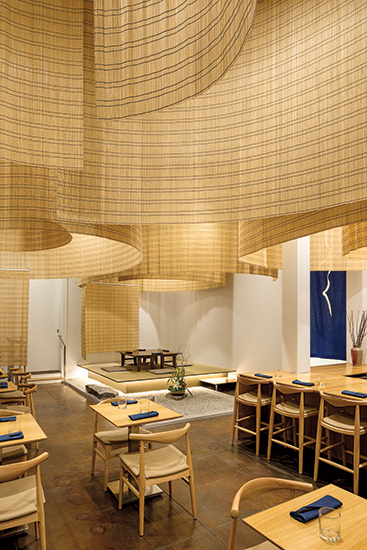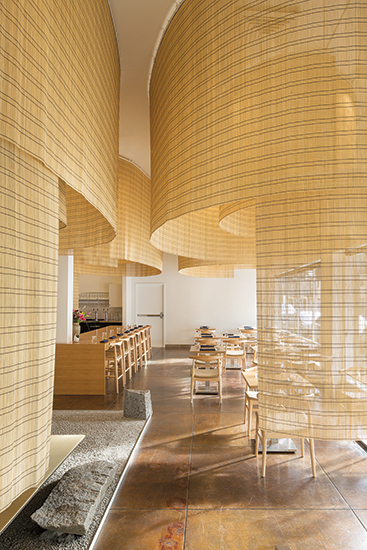"Shizuku by Chef Naoko" Restaurant by Kengo Kuma
Portland, Oregon

Suspended woven shades softly delineate table, counter, and tatami-mat seating, while the original concrete floor unifies the space. The raised area is also used for a traditional Japanese tea ceremony, whose implements are concealed beneath the tatami mats. Adjacent to the platform, the closed door leads to the restaurant’s private dining room.
Photo © Jeremy Bittermann

Sudare shades loosely divide the main dining room but also serve as a wallcovering behind the counter, framing the shelves that hold the various dishes required for kaiseki cuisine.
Photo © Jeremy Bittermann

Sudare shades loosely divide the main dining room but also serve as a wallcovering behind the counter, framing the shelves that hold the various dishes required for kaiseki cuisine.
Photo © Jeremy Bittermann

Image courtesy Kengo Kuma Associates




Architects & Firms
Like chef Naoko Tamura’s Japanese cuisine, Tokyo-based Kengo Kuma’s design for her Portland, Oregon, restaurant exploits the finest natural ingredients. Each component, be it wood or stone, is rendered with attention to texture, color, and detail. Both the menu and milieu of “Shizuku by Chef Naoko” blend the refinement of Japan with the freshness of the Pacific Northwest.
Tamura—who met Kuma through a mutual acquaintance while he was working on the Portland Japanese Garden (PJG)—had a small restaurant in a single-story commercial building. When a neighboring business moved out, the chef asked the architect to design an expansion.
Kuma created an airy 1,200-square-foot scheme with a new dining room in the acquired adjacent space. Parallel to the street, his oblong plan has three eating areas: a group of Western-style tables and chairs, a counter with stools, and, opposite the entrance, tatamimat seating. His design also included the transformation of Tamura’s existing 256- square- foot eatery into a private event venue. Along the rear of the joined properties, a kitchen, designed by architect of record Lorraine Guthrie, is triple the size of the old one.
Capitalizing on the building’s 14-foot ceiling height, the restaurant’s defining feature is a sequence of swirling sudare shades suspended overhead. Dynamic yet delicate, these lightweight screens loop gracefully, enlivening the top of the room as they implicitly divide the bottom. While their concave surfaces suggest clusters of seating, their convex surfaces imply circulation pathways in between.
Traditional Japanese roll shades used for privacy and sun protection, sudare are made of bamboo filaments woven loosely together with thread to allow air and light through; outside Japan, they are often used for interiors to evoke the country’s flavor. Here the architects achieved an entirely new effect by hanging the screens widthwise from the ceiling, which generated their curling shapes. Manufactured in Japan’s Fukuoka Prefecture, the restaurant’s sudare measure 6 feet across, the loom’s maximum width, and up to 40 feet long. Determining the precise curvature of each piece was “pretty low-tech,” says project architect Balazs Bognar. But affixing the shades took ingenuity and craftsmanship. Working on-site, the local contractor traced the shades’ profiles onto the restaurant’s concrete floor. Guided by these lines, he bent the pairs of metal bands that support the top edge of each screen. He then sewed the shades and bands together with stainless-steel thread before attaching the whole construct to the drywall ceiling.









